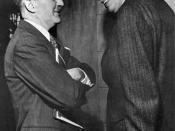The Federal Reserve System is the central banking system of the United States, created in 1913 by the enactment of the Federal Reserve Act. The Federal Reserve Act, is the act of Congress that created the Federal Reserve System, the central banking system of the United States of America, which was signed into law by President Woodrow Wilson. For nearly eighty years, the U.S had been operating without a central bank after the charter for the Second Bank of the United States expired. However, after various financial panics, particularly a severe one in 1907, there was a growing consensus in the American financial community that some sort of banking and currency reform was needed which could provide a ready reserve of liquid assets in case of financial panics and would also provide for a currency that could expand and contract as the seasonal U.S. economy dictated.
The seven-member Board of Governors is the main governing body of the Federal Reserve System.
It is charged with overseeing the 12 District Reserve Banks and with helping implement national monetary policy. Governors are appointed by the President of the United States and confirmed by the Senate, one on Jan. 31 of every even-numbered year, for staggered, 14-year terms. As an independent federal government agency, the Board of Governors does not receive funding from Congress, and the terms of the seven members of the Board span multiple presidential and congressional terms. Once a member of the Board of Governors is appointed by the president, he or she functions mostly independently. The Board is required to make an annual report of operations to the Speaker of the U.S. House of Representatives. It also supervises and regulates the operations of the Federal Reserve Banks, and US banking system in general terms. Once a member of...


